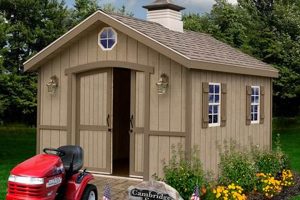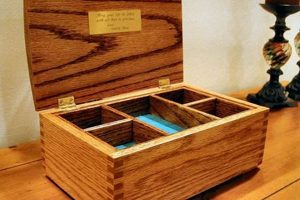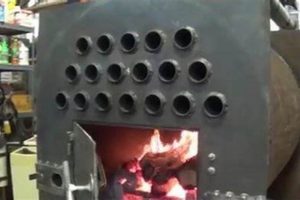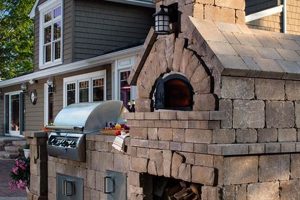The practice of constructing a heating appliance from a repurposed pressurized gas cylinder represents a resourceful adaptation of readily available materials. Individuals often undertake this endeavor to create an independent and potentially cost-effective source of heat, particularly in off-grid living situations or as a supplementary heating system. The core principle involves modifying a used container to safely and efficiently burn wood as fuel.
This type of project allows for a degree of self-sufficiency, enabling individuals to utilize otherwise discarded materials. Furthermore, reliance on this type of heating system can reduce dependence on conventional energy sources, contributing to a more sustainable lifestyle. Historically, the creation of homemade stoves from available scrap materials has been a common practice in environments where manufactured appliances are either unavailable or unaffordable.
The following sections will detail the steps involved in the construction of such a heating appliance, the necessary safety precautions, and considerations for optimal performance. Emphasis will be placed on safe practices and proper design to ensure both user safety and efficient heat output.
Essential Considerations for Safe and Effective Heating Appliance Construction
The construction of a heating appliance from a repurposed pressurized gas cylinder requires meticulous attention to detail and adherence to safety protocols. The following tips outline crucial aspects of the build process.
Tip 1: Thoroughly Depressurize and Clean the Tank: Before any cutting or welding commences, ensure the tank is completely empty of propane. Fill the tank with water multiple times, draining it each time to displace any residual gas. A thorough cleaning eliminates the risk of explosion.
Tip 2: Strategically Plan Airflow: Design the intake and exhaust vents to promote efficient combustion. Insufficient airflow results in incomplete burning, producing excessive smoke and reducing heat output. Conversely, excessive airflow can lead to rapid fuel consumption.
Tip 3: Utilize Proper Welding Techniques: Employ welding methods appropriate for the thickness and type of steel used in the tank. Inadequate welds can compromise the structural integrity of the heating appliance, posing a safety hazard.
Tip 4: Incorporate a Secure Door and Latch Mechanism: The door must seal tightly to prevent air leaks and maintain combustion control. A reliable latch mechanism ensures the door remains closed during operation, preventing accidental spills of burning embers.
Tip 5: Implement a Chimney or Flue System: A properly installed chimney or flue is essential for venting exhaust gases safely away from the dwelling. Ensure the flue has adequate draft to prevent backdrafting, which can introduce carbon monoxide into the living space.
Tip 6: Consider a Baffle System: Internal baffles can improve heat retention and combustion efficiency. Baffles redirect hot gases, allowing for more complete combustion and increasing the amount of heat radiated into the room.
Tip 7: Prioritize Proper Placement and Clearance: Position the heating appliance on a non-combustible surface and maintain adequate clearance from walls and other flammable materials. This minimizes the risk of fire.
Adhering to these guidelines enhances the safety and effectiveness of a heating appliance constructed from a repurposed pressurized gas cylinder, contributing to a reliable and efficient heating solution.
The subsequent section will address the potential risks and regulatory considerations associated with constructing and operating this type of appliance.
1. Tank Preparation
Proper tank preparation is a non-negotiable prerequisite for the safe construction of a heating appliance from a repurposed gas cylinder. It establishes the foundation for a successful and hazard-free build, directly influencing the overall safety and functionality of the resulting heating device.
- Complete Depressurization
Ensuring the tank is entirely free of propane is paramount to prevent explosions during cutting or welding. This process typically involves opening the valve and allowing any residual gas to vent completely. Failure to achieve complete depressurization creates an extremely dangerous environment where even minor sparks can trigger a catastrophic event. Double-checking with a gas detector is highly recommended.
- Multiple Water Fillings
After depressurization, the tank should be filled and emptied with water multiple times. This process displaces any remaining propane vapor and helps to neutralize any residual odor. Each filling should be followed by a thorough draining to ensure no pockets of gas remain trapped within the tank. This step is crucial for minimizing the risk of fire or explosion during subsequent work.
- Valve Removal and Inspection
The valve assembly should be removed and inspected for damage or corrosion. A damaged valve can impede the thorough cleaning process and potentially leak residual gas. Furthermore, the opening left by the removed valve allows for better ventilation during the cleaning process. If the valve is corroded, it should be replaced with a suitable plug for safety reasons.
- Visual Inspection for Damage
Before any modifications are made, the tank’s exterior and interior (as far as possible) should be visually inspected for signs of rust, corrosion, or dents. A compromised tank may be structurally unsound and unsuitable for repurposing as a heating appliance. Any significant damage should preclude the use of the tank for this purpose.
The effectiveness of the tank preparation directly impacts the overall safety and long-term performance of the heating appliance. Skimping on these initial steps introduces unacceptable risks that can compromise the entire project. Comprehensive and diligent preparation is the foundation upon which a safe and functional heating appliance is built.
2. Airflow Dynamics
Airflow dynamics constitute a critical element in the design and operation of a heating appliance constructed from a repurposed propane tank. The principles governing the movement of air within the combustion chamber directly influence the efficiency of combustion, the heat output of the appliance, and the safety of its operation. Adequate and controlled airflow is essential for complete combustion, minimizing harmful emissions, and maximizing heat transfer.
- Primary Air Intake
The primary air intake provides the initial oxygen supply necessary to ignite and sustain the burning of wood fuel. The size and placement of this intake directly influence the rate of combustion. An undersized intake restricts the oxygen supply, leading to incomplete combustion and the production of excessive smoke and carbon monoxide. Conversely, an oversized intake can result in rapid fuel consumption and reduced heat retention within the appliance. The primary air intake is typically located near the base of the combustion chamber, allowing air to flow upward through the fuel bed.
- Secondary Air Injection
Secondary air injection introduces additional oxygen into the upper portion of the combustion chamber to burn off uncombusted gases and particulate matter produced during the initial combustion phase. This secondary combustion process reduces smoke emissions, increases heat output, and improves overall efficiency. The placement and control of secondary air inlets are crucial for optimizing this process. Secondary air is often preheated to further enhance combustion efficiency.
- Chimney Draft and Exhaust
The chimney draft is responsible for drawing combustion gases out of the appliance and venting them safely away from the dwelling. A properly sized and installed chimney creates a negative pressure within the appliance, promoting airflow through the combustion chamber. Insufficient chimney draft can lead to backdrafting, where exhaust gases are drawn back into the living space, posing a significant health hazard. Factors affecting chimney draft include chimney height, diameter, and insulation.
- Combustion Chamber Design
The internal design of the combustion chamber influences the flow of air and gases within the appliance. Baffles, deflectors, and strategically placed obstructions can redirect airflow to promote turbulence and mixing, enhancing combustion efficiency and heat transfer. A well-designed combustion chamber maximizes the residence time of combustion gases, allowing for more complete burning and reduced emissions.
The interplay of these airflow dynamics directly impacts the performance and safety of a heating appliance constructed from a repurposed gas cylinder. A careful consideration of these principles during the design and construction phases ensures optimal combustion, efficient heat output, and minimal environmental impact. Ignoring these factors can lead to inefficient operation, excessive smoke production, and potentially hazardous conditions. Mastering these principles can lead to create better “diy propane tank wood stove”.
3. Welding Integrity
Welding integrity is paramount in the construction of a heating appliance from a repurposed gas cylinder. The structural soundness and safe operation of the finished product depend directly on the quality and durability of the welds that join the various components. Compromised welds can lead to structural failure, creating a significant safety hazard.
- Selection of Welding Process
The appropriate welding process must be selected based on the type and thickness of the steel used in the tank construction. Shielded Metal Arc Welding (SMAW), Gas Metal Arc Welding (GMAW), or Gas Tungsten Arc Welding (GTAW) may be suitable, depending on the specific requirements. SMAW is often used due to its versatility and suitability for thicker materials, while GMAW offers higher productivity for thinner gauges. GTAW provides the highest quality welds but requires more skill and time. Improper process selection can result in weak or porous welds, compromising the structural integrity of the appliance.
- Preparation of Welding Surfaces
Proper preparation of the surfaces to be welded is critical for achieving strong and reliable welds. This includes removing any rust, scale, paint, or other contaminants that could interfere with the welding process. Grinding, wire brushing, or chemical cleaning may be necessary to ensure a clean welding surface. Failure to adequately prepare the surfaces can lead to poor weld penetration and reduced weld strength.
- Weld Bead Placement and Technique
The placement and technique used to create the weld beads significantly impact the overall strength and durability of the weld. Multiple passes may be necessary to achieve the required weld thickness and strength. Proper overlap between weld beads is essential to prevent gaps or weak points. The welding technique should be adjusted based on the welding process, material thickness, and joint configuration. Incorrect bead placement or technique can result in stress concentrations and premature weld failure.
- Post-Weld Inspection and Testing
After welding, a thorough inspection of the welds should be conducted to identify any defects, such as cracks, porosity, or incomplete fusion. Visual inspection, dye penetrant testing, or ultrasonic testing may be used to detect these defects. Any defects should be repaired before the appliance is put into service. Post-weld heat treatment may also be necessary to relieve stress and improve the mechanical properties of the welds. Proper inspection and testing are crucial for ensuring the long-term reliability and safety of the heating appliance.
The welding integrity of a repurposed gas cylinder heating appliance directly impacts its ability to withstand the stresses of repeated heating and cooling cycles. Weak or poorly executed welds can crack or fail over time, potentially leading to dangerous situations such as gas leaks or structural collapse. Diligent attention to welding processes, surface preparation, technique, and inspection is essential for ensuring the safe and reliable operation of this type of heating appliance.
4. Flue System
A properly designed and installed flue system is integral to the safe and efficient operation of a heating appliance constructed from a repurposed propane tank. The flue serves as the conduit for channeling combustion byproducts away from the living space, preventing the accumulation of harmful gases and ensuring adequate draft for sustained combustion.
- Draft Creation and Maintenance
The flue system establishes a pressure differential between the appliance and the external environment, known as draft. This draft facilitates the continuous removal of combustion gases, preventing backdrafting into the living space. The height and diameter of the flue, along with insulation factors, contribute to the strength and stability of the draft. Insufficient draft results in incomplete combustion and the potential for carbon monoxide poisoning, while excessive draft can lead to rapid fuel consumption and heat loss.
- Material Selection and Durability
Flue systems require materials capable of withstanding high temperatures and corrosive combustion byproducts. Stainless steel or insulated chimney components are commonly employed for their durability and resistance to deterioration. Improper material selection can lead to premature failure of the flue, posing a fire hazard and compromising the system’s ability to safely vent exhaust gases.
- Termination Height and Location
The flue termination point must be strategically located to ensure proper dispersal of combustion gases away from the building and surrounding structures. Building codes typically specify minimum height requirements and clearances from windows, doors, and air intakes to prevent re-entry of exhaust fumes. Improper termination can lead to nuisance smoke and potential health hazards for occupants and neighbors.
- Maintenance and Inspection Protocols
Regular inspection and maintenance of the flue system are essential for identifying and addressing potential issues such as creosote buildup, blockages, or structural damage. Creosote, a highly flammable byproduct of incomplete combustion, can accumulate within the flue, increasing the risk of chimney fires. Routine cleaning and inspection help to maintain the flue’s efficiency and prevent hazardous conditions.
The flue system, therefore, is not merely an accessory but an essential component of a heating appliance constructed from a repurposed container. Its proper design, installation, and maintenance are critical for ensuring safe, efficient, and environmentally responsible operation. Neglecting these considerations can have severe consequences, highlighting the importance of adhering to established best practices and regulatory guidelines.
5. Safety Measures
The implementation of rigorous safety measures is not merely advisable but absolutely indispensable when undertaking the construction and operation of a heating appliance fabricated from a repurposed gas cylinder. The inherent risks associated with handling flammable materials, high temperatures, and potentially compromised structural components necessitate a comprehensive and unwavering commitment to safety protocols.
- Adequate Clearance and Non-Combustible Surfaces
Maintaining sufficient clearance between the heating appliance and any combustible materials is crucial to prevent accidental fires. This includes walls, furniture, and any other flammable items in the vicinity. The appliance must be placed on a non-combustible surface, such as concrete or stone, to isolate it from potentially flammable flooring. Inadequate clearance is a leading cause of residential fires, particularly involving solid-fuel heating appliances. Real-world examples highlight the devastating consequences of neglecting this basic safety precaution, often resulting in property damage, injuries, or fatalities. The proximity of combustibles drastically elevates the risk profile of these installations.
- Carbon Monoxide Detection and Ventilation
Carbon monoxide (CO) is an odorless, colorless gas produced by the incomplete combustion of fuels, including wood. Exposure to CO can be fatal. Installing a CO detector in the vicinity of the heating appliance is essential for providing early warning of dangerous CO levels. Proper ventilation, including a functioning chimney and adequate air supply, is necessary to ensure complete combustion and prevent CO buildup. Instances of CO poisoning due to faulty or improperly installed wood-burning appliances are well-documented, underscoring the critical importance of CO detection and ventilation.
- Fire Extinguisher and Emergency Preparedness
Having a readily accessible fire extinguisher suitable for Class A fires (those involving ordinary combustibles like wood) is a critical safety measure. All occupants of the dwelling should be familiar with the location and proper use of the fire extinguisher. An emergency plan, including evacuation routes and contact information for emergency services, should be established and practiced regularly. The rapid response capabilities afforded by a fire extinguisher and a well-rehearsed emergency plan can significantly mitigate the consequences of a fire event.
- Regular Inspection and Maintenance
Periodic inspection of the heating appliance and its associated components, including the chimney and flue, is crucial for identifying and addressing potential safety issues. This includes checking for cracks, leaks, creosote buildup, and other signs of deterioration. Regular maintenance, such as cleaning the chimney and repairing any damage, is necessary to ensure the appliance continues to operate safely and efficiently. Neglecting regular inspection and maintenance can lead to dangerous conditions, such as chimney fires or carbon monoxide leaks, that compromise the safety of the dwelling and its occupants.
These safety measures, when implemented comprehensively and consistently, significantly reduce the risks associated with utilizing a heating appliance constructed from a repurposed container. While this type of project can offer a cost-effective and independent heating solution, it must not come at the expense of safety. Diligence in adhering to established safety protocols is the only responsible approach to harnessing the benefits of this technology.
Frequently Asked Questions Regarding Repurposed Container Heating Appliances
This section addresses common inquiries and concerns pertaining to the design, construction, and operation of heating appliances fabricated from repurposed pressurized gas cylinders. The information presented is intended to provide clarity and promote safe practices.
Question 1: Is constructing a heating appliance from a repurposed propane tank inherently dangerous?
When executed without proper knowledge, planning, and safety precautions, the construction poses substantial risks. However, with meticulous adherence to established safety protocols, including thorough tank preparation, appropriate welding techniques, and adequate ventilation, many inherent dangers can be significantly mitigated. The risk profile decreases substantially with expertise and rigorous safety practices.
Question 2: What is the most critical safety precaution to observe during construction?
Complete and verifiable depressurization and cleaning of the propane tank prior to any cutting or welding activities are unequivocally the most critical safety measures. Failure to eliminate all residual propane vapor creates an explosive environment, rendering even minor sparks potentially catastrophic.
Question 3: What are the key considerations for achieving efficient combustion in a repurposed tank heating appliance?
Effective combustion requires careful attention to airflow dynamics. This encompasses strategic placement and sizing of primary and secondary air intakes, along with ensuring adequate chimney draft. Proper combustion chamber design, including the incorporation of baffles, can also significantly enhance efficiency.
Question 4: Does the type of welding process employed significantly impact the safety of the appliance?
Yes. The chosen welding process must be appropriate for the type and thickness of the steel used in the tank construction. Furthermore, the welding must be performed by a qualified individual with expertise in the selected process. Inadequate weld penetration or the use of improper welding techniques can compromise the structural integrity of the appliance, creating a potential hazard.
Question 5: Is a carbon monoxide detector truly necessary when operating a repurposed tank heating appliance?
A carbon monoxide detector is not merely recommended but is a mandatory safety device. Carbon monoxide is an odorless, colorless, and potentially lethal gas produced by incomplete combustion. A functioning CO detector provides early warning of elevated CO levels, allowing for prompt corrective action and preventing potentially fatal exposure.
Question 6: What are the potential legal or regulatory implications of constructing and operating a repurposed tank heating appliance?
The construction and operation of such appliances may be subject to local building codes, fire regulations, and insurance requirements. It is the responsibility of the individual undertaking this project to investigate and comply with all applicable laws and regulations. Failure to do so can result in fines, legal penalties, or denial of insurance coverage.
The knowledge presented in this FAQ section serves as a crucial guide in addressing the concerns surrounding the project. A detailed comprehension of these factors is essential for anyone considering it.
The subsequent section will outline potential alternatives to constructing a heating appliance from a repurposed container.
diy propane tank wood stove
This exploration has detailed the multifaceted considerations involved in constructing a heating appliance from a repurposed pressurized gas cylinder. From the imperative of thorough tank preparation to the nuanced dynamics of airflow and the critical importance of welding integrity and proper flue systems, the intricacies of such a project demand meticulous attention. The paramountcy of safety measures, including CO detection and adherence to clearance requirements, has been consistently emphasized.
The information presented herein should serve as a foundational understanding for individuals contemplating this endeavor. While the prospect of creating an independent heat source is compelling, a responsible assessment of one’s capabilities, adherence to established safety protocols, and compliance with local regulations are non-negotiable. A misinformed or careless approach risks severe consequences, underscoring the need for rigorous preparation and informed decision-making.







